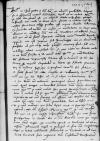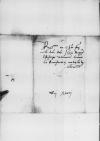List #2088
Paweł PŁOTOWSKI do Ioannes DANTISCUSFrauenburg (Frombork), 1539-03-05
| odebrano [1539]-03-07 Rękopiśmienne podstawy źródłowe:
Publikacje:
| ||||||
Tekst + aparat krytyczny + komentarzZwykły tekstTekst + komentarzTekst + aparat krytyczny
Reverendissimo in Christo Patri et Domino, domino
Reverendissime in Christo Pater et Domine, domine mi colendissime.
Praehibita diligenti sui et obsequiorum meorum commendatione.
Quod ex me voluit Reverendissima Paternitas Vestra, diu factum est nec aliquando cordis mihi fuit quicquam inhonesti me velle in domo mea fovere et nutrire, nisi honestos servitores absque quibus esse nequeo. Ancilla redierat ex servitio ad matrem me inscio et occultabatur in domo mea. Admonui et mandavi matri, ut eam remitteret ad addictum servitium. Quae cum non statim comparavit mandatis meis, ancillam baculo expuli nec est
Nobilis dominus
Quod tangit mulierculas, solutas dominas dominorum canonicorum, novit Reverendissima Paternitas Vestra melius hoc genus hominum varia in similibus dicere et molire, sed si Reverendissima Paternitas Vestra superinscribed⌈VestraVestra superinscribed⌉ coeptum continuaverit, imporscortores(!) cum scortis nil efficient nec consilium domini Leonardi episcopi nescio cuis ecclesiae praevalebit. Licet me bestiam coram Reverendissimam Paternitatem Vestram nominavit, qui solus bestiam vicit, et superbum, brutum, opacum, ego non desistam adhaerere Reverendissimae Paternitati Vestrae tamquam domino meo et qui merito inhonestatem ecclesiae suae vero iure prosequitur in laudem Dei et omnium bonorum.
Nova, quae accepi. Sacra  BCz, 1597, p. 554 hoc est ad testudinem altioris arcis
BCz, 1597, p. 554 hoc est ad testudinem altioris arcis
Scribit mihi dominus
Clarissima virgo
De
Reverendissima Paternitas Vestra velit committere servitori suo, qui iturus est Cracoviam, quod litteras, quas scribo, amicis offerre velit et iterum responsum reportare, enixe oro.
Datum
Eiusdem Reverendissimae Paternitatis Vestrae addictissimus servitor
Postscript No. 1:
Si quid non placet in litteris scriptis, boni consulere velit R stain⌈[R]R stain⌉everendissima Paternitas Vestra, precor.
Postscript No. 2:
 BCz, 1597, f. [1]v missed in numbering after p. 554
BCz, 1597, f. [1]v missed in numbering after p. 554
Venerabilis dominus
Cum his me iterum atque iterum commendo gratiae Reverendissimae Paternitati Vestrae, optans eadem diu et felicissime vivere.


